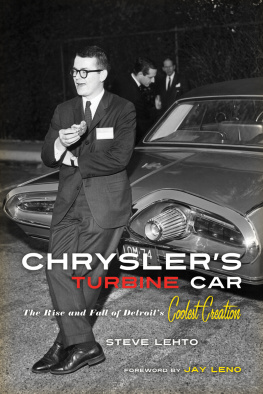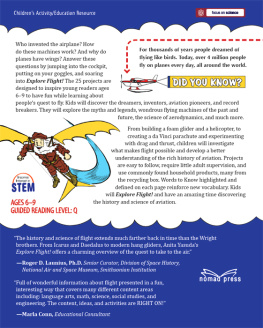
Copyright 2013 by Steve Lehto
All rights reserved
First edition
Published by Chicago Review Press, Incorporated
814 North Franklin Street
Chicago, Illinois 60610
ISBN 978-1-61374-430-7
Library of Congress Cataloging-in-Publication Data
Lehto, Steve.
The great American jetpack : the quest for the ultimate individual lift device / Steve Lehto. First edition.
pages cm
Includes bibliographical references and index.
ISBN 978-1-61374-430-7 (hardback)
1. Personal propulsion unitsUnited StatesHistory. 2. Aeronautical engineers United StatesBiography. I. Title.
TL717.5.L44 2012
629.14dc23
2012039337
Cover design: John Yates at Stealworks.com
Interior design: Jonathan Hahn
Printed in the United States of America
5 4 3 2 1
For
Milo and Wolfy,
Brandy and Sangria.
CONTENTS

INTRODUCTION
In his 1887 book The Clipper of the Clouds, Jules Verne described a fictional meeting of scientific gentlemen debating whether man might fly, and if so, how. A stranger appeared before them and announced that lighter-than-air contraptions such as hot air balloons were impractical. The bigger they were, the harder they were to maneuver. No, the answer lay in heavier-than-air flight. Over the clamorous objections of his learned audience, the man boldly predicted:
Yes, the future is for the flying-machine. The air affords a solid fulcrum. If you will give a column of air an ascensional movement of forty-five metres a second, a man can support himself on the top of it if the soles of his boots have a superficies of only the eighth of a square metre. And if the speed be increased to ninety metres, he can walk on it with naked feet. Or if, by means of a screw, you drive a mass of air at this speed, you get the same result.
A man walking in the sky? In August 1928, the science fiction magazine Amazing Stories featured a cover with a colorful drawing of the Skylark of Space, a futuristic character hovering a few feet off the ground, held in the air by a small device on his back.
The Skylark of Space has been largely forgotten but inventors did build a working model of the device on his back. It would eventually creep into the consciousness of America, and people across the United States saw men flying in the same manner as the Skylark of Space, zooming around effortlessly in the sky as if gravity had finally been made obsolete. The men, wearing what most people would mistakenly call jet packs, became ubiquitous in the 1960s and 1970s. The devices were featured in movies and television shows and hovered over Super Bowl halftimes and Olympic opening ceremonies. They became known worldwide. But then they seemingly vanished from the landscape. Only a few isolated stories would pop up from time to time of inventors reviving the technology, or diehard enthusiasts working to keep the technology alive, flying the devices in demonstrations and at public events.
The story of the jet pack is really the story of mans dream of flying. Not in the manner of the Wright Brothers, who built a huge flying machine that could take off and fly with more than a little bit of effort. The jet packor the individual lift devices, as they were blandly labeled by the government men who financed much of their developmentanswered mans desire to simply step outside and take flight. No runways, no wings, no pilots license required. Soaring through the air with the wind in your face and landing anywhere there was room to stand. Could it be done? Yes, it could be done, and it was.
A vehicle that takes off vertically, like a helicopter, is described as vertical take-off and landing, or VTOL. The personal flight devices covered in this work are, for the most part, vertical take-off and landing devices. This attribute separates them from small airplanes and gliders, and makes them closer to the notion that one could simply step outside and take flight. VTOL vehicles do not require landing strips or airports. They just need a place to land and a view of the sky.
To the average person, the term jet pack is often used to describe any individual lift device, regardless of its means of propulsion. To a purist, the first such device that flew safely and practically was called a rocket belt. It was powered by a chemical reaction that created thrust and it flew for less than half a minute. Later models powered by small jet engines flew longer and were real jet packs, but they were deemed jet belts to keep in line with the belt terminology.
Although early developments in the field showed promise, the technology stalled. The practical jet pack seemed tantalizingly close but always just out of reach. When one problem was solved, another would replace it. The only constant was the promisethe promise that jet packs would soon be here, available for everyone. But soon never came.
The story of individual lift technology truly started with the advent of flying platforms in the 1940s. Shortly after the platforms came the rocket belts, and then the jet belts. Innovation in these designs followed an interesting trajectory. The individual lift devices morphed from carrying a passenger to being worn by the passenger. Later they came full circle, returning to something a passenger stood on to be lifted skyward. Innovations in the twenty-first century even allowed a man to fly across the English Channel wearing a descendant of the jet belt.
A common thread among these devices is that the pilot and the machine were usually connected, often attached, to each other. Further, these flying machines were controlled to a large extent by the movements of the pilot, something called kinesthetic control. While airplanes and helicopters required trained pilots to work levers, pedals, joysticks, and yokes, the individual lift devices often had nothing more than a handle or twothe pilot simply leaned or twisted in the direction he wanted to travel. It was this last pointthe ease with which an untrained pilot could take to flightthat was often the major selling point made by the promoters of this technology.
This promise of ease in operation resulted in eventual disappointment for the people who hoped to fly like this someday. The jet pack was perhaps the most overpromised technology of all time. Creators of the flying platforms, rocket and jet belts, and the later flying devices and the men who flew them audaciously promised that one day, we would all have them.
And then, in the twenty-first century, the largest strides were made in the development of these devices. While engineers and hobbyists revisited the technology of the rocket belts, doing what they could to tweak more than a half minute of flying time from units modeled on the 1950s versions of the rocket belt, a Swiss pilot and inventor named Yves Rossy built a flying apparatus that came perhaps the closest yet to mans dream of free flight. His creation was a small wing fitted with miniature turbine engines, technology that did not exist in the 1950s. Jetman Rossy crossed the English Channel and flew over the Alps with his jet pack using nothing more than his body movements to steer. Perhaps the dream of individual flight is within human reach after all.
___________
This is an admittedly artificial distinction being made by the author. There were also one-person helicopters and hovercraft that could be considered similar to the devices being written about here. However, for the purposes of this work, the author is sticking to what appears to be a logical class of devices: those that appeared simplest to operate and offered the average man the ability to fly without wings.
Next page












